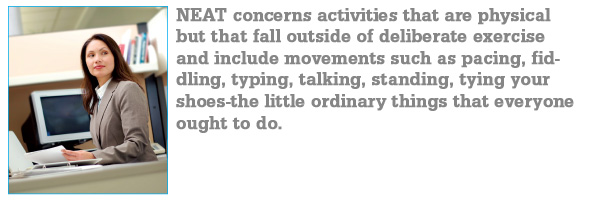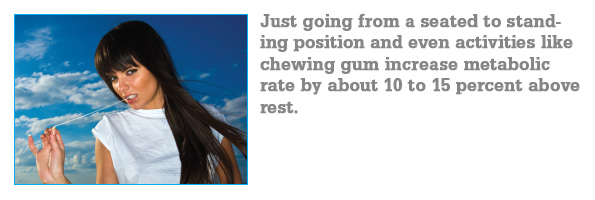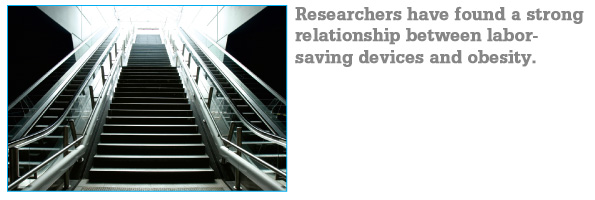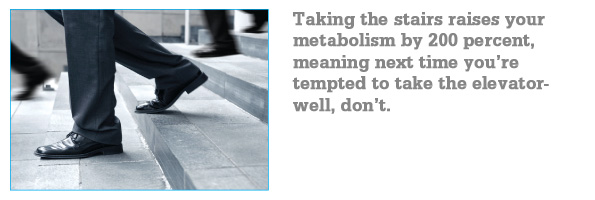Cardiovascular exercise is one of the more difficult aspects of bodybuilding, but it’s a necessity if you want to get shredded. In Part 1 of this series we discussed top-flight scientific information and the benefits of both moderate and high-intensity cardio for optimum fat loss. In this installment we’ll discuss the science behind an activity that, surprisingly, you perform away from the gym.

First let’s go back a few years, when Jacob had the privilege of attending a unique presentation at the annual meeting of the American College of Sports Medicine. The speakers included world-renowned experts on how activity can determine individual body composition. Normally during a presentation one speaker at a time will stand and present, while his or her colleagues sit in their designated seats awaiting their turns. What intrigued the crowd was that the speakers were all standing during the entire discussion, even when they weren’t speaking. Even more interesting was that, as the presentation continued, the audience began to stand until by the end of the presentation all had abandoned their chairs. Why? Read on.
A “NEAT” Approach to Increasing Energy Expenditure
As the hardcore readers of IRON MAN magazine are aware, “calories in vs. calories out” is the most important variable in determining whether you gain or lose weight. Calories in are affected by diet, and while calories out are affected by many variables, including basal metabolic rate, the thermic effect of food and activity-induced thermogenesis.1

Basal metabolic rate is the energy you expel while at rest and averages out to be about 60 percent of total energy expelled in a given day. Studies show that the difference between individuals basal metabolic rates, such as hat makes one person expend more calories than another, is explained mainly by differences in mass.2 The thermic effect of food is the energy required to digest, process and assimilate food; that accounts for 10 to 15 percent of calories expended in a given day.
The final category can be further divided into exercise-activity and nonexercise-activity thermogenesis, the latter usually called NEAT. NEAT concerns activities that are physical but that fall outside of deliberate exercise and include movements such as pacing, fiddling, typing, talking, standing, tying your shoes—the little ordinary things that everyone ought to do at work or school. Studies indicate that NEAT may explain most of the difference between individuals in terms of their total energy expended. Indeed, the effects of NEAT range from 15 to 50 percent of total calories burned in a given day.1,2 So you want to maximize NEAT in your daily life.
What Affects NEAT
How much NEAT people get in a given day appears to be affected by three primary factors: environment, genetics and diet. Environmental factors increase or deter opportunities for NEAT. As you would expect, the weather has a major influence on NEAT, which doubles in the summer compared to winter months. Likewise, a physically active occupation will result in greater NEAT than a desk job.

Lastly, the creation of such labor-saving devices as dishwashers, washing machines and elevators has dramatically reduced NEAT in our country. Researchers have found a strong relationship between labor-saving devices and obesity. Studies show that individuals who do not rely heavily on labor-saving devises can expend enough extra calories in a given year to metabolize nearly 12 pounds of fat. To make that point clear, you need look only at how NEAT affects metabolism. Just going from a seated to standing position and even activities like chewing gum increase metabolic rate by about 10 to 15 percent above rest. Fidgeting increases metabolism by 40 percent, while walking from one, two or three miles an hour increases the metabolic rate by 100, 150 and 200 percent, respectively. Taking the stairs raises your metabolism by 200 percent, meaning next time you’re tempted to take the elevator—well, don’t.3
From a genetics perspective, there’s a positive relationship between leanness and greater levels of NEAT. That may be because people who tend to gain weight more easily and thus carry more fat have a harder time moving. When obese people lose weight, they still don’t perform as much NEAT as their lean counterparts.3

Applied to bodybuilders, it may be that those who stay leaner in the off-season, even though they’re bulking, simply have more NEAT than bodybuilders who tend to store fat. More direct evidence for a genetic influence is found in a class of hormones known as orexins. Orexins are known to increase NEAT, yet when they’re administered to the brain, lean individuals increase NEAT substantially more than people who have a tendency to store fat easily, suggesting that these individuals may be resistant to orexins’ activity-stimulating effects.
A final factor that affects NEAT is the diet and calorie balance. When people eat more food, they spontaneously increase such NEAT activities as pacing; that may be to maintain bodyweight by increasing energy expenditure. Conversely, when losing weight and dieting, people naturally lower NEAT, though we’re cautious about saying that. Of you binge eat, for example, you’re not likely to move more. You’ll be bloated and fat, and you’ll stimulate the parasympathetic nervous system, which tells the body to rest and digest. We’ve all at one time or another experienced that on a hardcore bulking phase. That’s why we believe you’ll have the highest NEAT around maintenance calories—enough to provide energy but not too many to ramp up the parasympathetic nervous system.
Novel Ways to Increase NEAT
Increasing NEAT is really a lifestyle change—simple modifications to everyday tasks. Because NEAT can account for up to 50 percent of the calories you expend, those simple modifications can mean the difference between your hitting a plateau or getting shredded.

1) If you have a desk job, modify the station where you spend much of your day. Instead of sitting on your behind, arrange your desk so you can stand while you type. That was one of the key points made during the seminar. Think about it: You can burn 15 percent more calories during your work day than you normally have.
2) You’ve seen the picture of people taking the elevator to the gym. Well, take the stairs. That increases your metabolism by 200 percent.
3) How many times have you seen people drive around looking for that perfect parking space right next to the store? Instead, park farther away from the store and just walk a little bit more to get inside.
4) Chewing a piece of gum over a 24-hour period may raise metabolism by up to 15 percent—chewing 20 pieces of five-calorie gum per day might just be a wash.
5) Try studying or reading a paper while pacing, not sitting.
6) Instead of standing around between sets in the gym, pace.
7) A pedometer is the ultimate NEAT machine, a small device that counts how many steps you take every day. All you do is place it on your hip, and it takes care of the rest. You won’t even know it’s there. You can even wear it in the gym. People who wear a pedometer also perform more NEAT because the device gives them reinforcement.4 The recommended number of steps per day is a minimum of 10,000.
8) Diet: You must not starve yourself, or your NEAT will naturally lower. Of course, if you’re on a cutting regimen, you must be in a calorie deficit, but by following a properly balanced nutritious diet instead of some new age crash program, you’ll perform more NEAT and lose more fat.
9) Constantly think of ways to perform NEAT. Let us know what you come up with.
Studies indicate that your amount of NEAT may account for as much as 50 percent of your daily energy expenditure. To increase it, you need to make lifestyle changes that keep your body in motion.
Now. As all of you are on your feet, feel free to applaud. It’s the end of another NEAT presentation.
Editor’s note: Gabriel Wilson is completing his Ph.D. in nutrition with an emphasis on optimal protein requirements for muscle growth and is a researcher in the Division of Nutritional Sciences, University of Illinois, Urbana. He is vice president of the Web site ABCBodybuilding.com. Jacob Wilson is a skeletal-muscle physiologist and researcher in the Department of Nutrition, Food, and Exercise Science, Florida State University, Tallahassee. He is president of the Web site ABCBodybuilding.com.
References
1 Levine, J.A., et al. (2006). Non-exercise activity thermogenesis: The crouching tiger hidden dragon of societal weight gain. Arterioscler Thromb Vasc Biol. 26(4):729-736.
2 Levine, J.A. (2004). Non-exercise activity thermogenesis (NEAT). Nutr Rev. 62(7 Pt 2):S82-97.
3 Levine, J.A. (2004). Nonexercise activity thermogenesis (NEAT): Environment and biology. Am J Physiol Endocrinol Metab. 286(5):E675-685.
4 Bravata, D.M., et al. (2007). Using pedometers to increase physical activity and improve health: A systematic review. JAMA. 298(19):2296-2304. IM




















You must be logged in to post a comment Login